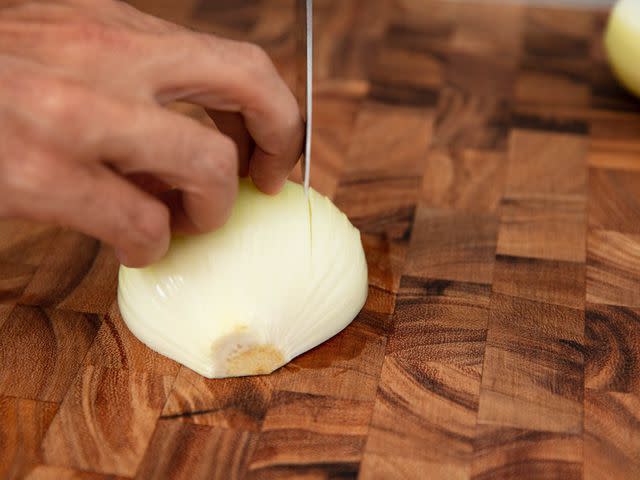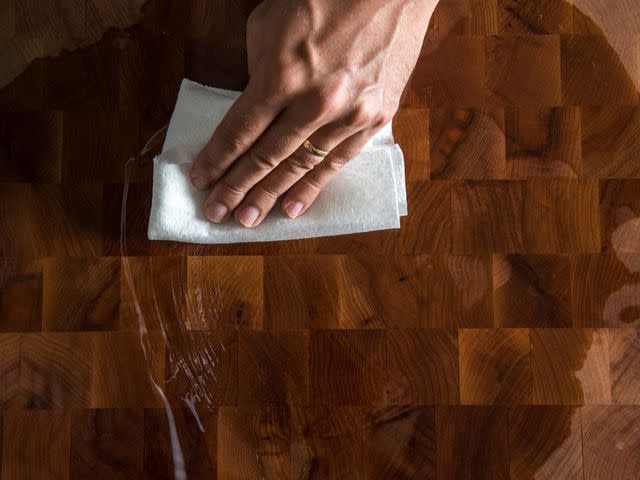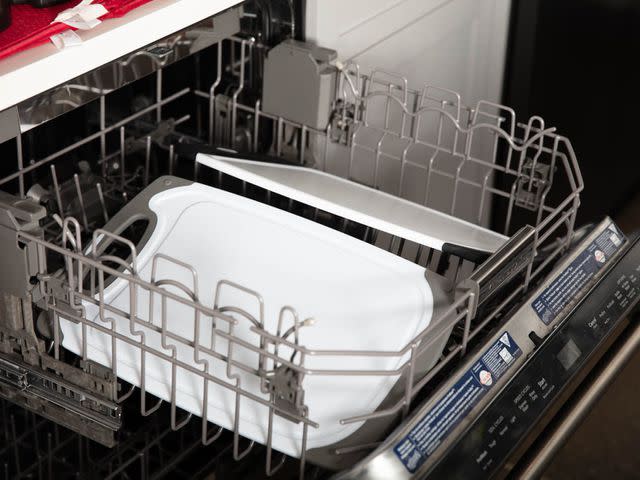Wood Versus Plastic Cutting Boards
The relative merits of wood and plastic cutting boards.

Serious Eats / Vicky Wasik
A cutting board is a lot like a mattress—underestimate the importance of getting a quality one, and you'll regret it. It is the primary work surface in your kitchen, the place where you dice onions, cut up raw chicken, and pound your fists while cursing yourself for ever believing me that it's easy to trim artichokes.*
*It's not that hard. You should do it sometime, really.
There's a lot that goes into selecting a good cutting board, but don't you worry, we've done most of the legwork for you in our extensive reviews of plastic and wood cutting boards—but the first step is deciding between those two materials. Or, more likely, picking some combination of both.
To be clear, it really is just a question of wood or plastic. Glass cutting boards, or boards made from some other ludicrous choice like marble, aren't worth even a moment of consideration. Those materials are so hard they'll dull any knife that's used on them.
There are advantages and disadvantages to both wood and plastic, and the best option is to have each at home. Let's take a closer look.
Our Recommendation
One Large Wooden Cutting Board: One large wooden cutting board (as big as can comfortably fit in your kitchen) should be your workhorse. It should ideally be a well-constructed end-grain cutting board that's at least 1.25 inches thick (although a less expensive edge-grain board would be absolutely fine if you want to save some money). Read our wooden cutting board review for more details.
Two Plastic Cutting Boards in Two Sizes: One large, inexpensive, sturdy-but-light board that's dishwasher safe is handy to have when you expect to make a mess and want cleanup to be quick and easy. A smaller plastic board for quick tasks like cutting up a lemon is also very handy to have on hand. Read our plastic cutting board review for more details.
What Are the Pros and Cons of a Wood Cutting Board?

Serious Eats / Vicky Wasik
Wood is far and away the best material for cutting boards. It's durable, yet easy on knives; smooth but not slippery; and firm while still managing to absorb shocks.
Benefits of a Wooden Cutting Board
Wooden Cutting Boards Are Durable: A good wood cutting board can last...maybe not a lifetime, but a long, long time. Even if you damage the surface with deep scratches, the board can often be salvaged by sanding them away. Very few artificial materials are as forgiving as that.
Gentle on Knives: Not only is wood a pleasure to cut on, but wooden cutting boards made from woods like maple and walnut are much gentler on the blade of your knife than excessively hard woods, like bamboo, and plastics. Maple and walnut are both technically hardwoods, so they're durable, but still soft enough not to do tremendous damage to your knives.
Sanitary: Some people fear that wood, because it's porous and can absorb liquids, is unsanitary, but studies have often found the reverse—wood is able to absorb bacteria, trapping them and killing them. One study found that this can happen as quickly as three to 10 minutes after the surface of the board being contaminated with harmful bacteria, though greasy substances like chicken fat can remain on the surface of the board and continue to be a food-safety risk for many hours; washing in warm soapy water was sufficient to remove the harmful grease-borne bacteria. We should mention though that not every study has won out in wood's favor. In one study geared towards commercial kitchens, the researchers found that when both wood and plastic cutting boards were put through an aggressive hand- and machine-washing cycle, wood became the riskier material, likely because it broke down under the harsh washing regimen. Then again, no one should be running wood cutting boards through a dishwasher—ever—and hand-washing should be done gently. The moral here, really, is that wood needs to be treated with care and not abused in a commercial kitchen's dishwashing pit.
Aesthetically Pleasing: A wooden cutting board is handsome. That's maybe not the most important characteristic to consider when stocking your kitchen—certainly not important enough to outweigh any major flaws—but we'd be lying if we said it didn't matter to us at all. We want our kitchens to be spaces we enjoy cooking in, and looks, as they say, matter.
The Bad

Requires Some Upkeep: That's the main bad part: Wood needs to be cared for. It's an organic material, and it frequently needs to be conditioned with food-grade mineral oil to prevent it from drying out, warping, and cracking. Keeping a wooden cutting board saturated with oil also helps protect it from stains, since it'll be a little less eager to soak up every drop of liquid that touches it. Even with conditioning, a wood cutting board can fail. Warping and cracks are not uncommon, and problems often crop up on the seams where the pieces of wood are glued together. As I found in my review of wooden cutting boards, your best bet is to invest in a cutting board that's been made by a skilled woodworker. Cheaper wooden cutting boards with small but visible flaws tend to be more prone to breaking down.

Serious Eats / Vicky Wasik
More Work to Clean: Wooden cutting boards are more difficult to clean than plastic, too. You shouldn't put them in the dishwasher, nor should you leave them to soak, since extended exposure to water and high heat will pretty much guarantee a short life for the board. A gentle wash under warm running water is all that's needed, and then once the cutting board is dry, it's a good idea to give it a little more mineral oil to replenish whatever was stripped away with the soap and water.
Heavy and Unwieldy: Good wooden cutting boards are also heavy. Thin, lighter-weight ones are more prone to warping, so we don't recommend those. But there's no denying that the thicker ones we recommend are difficult to move around the kitchen. People who aren't able to haul a heavy cutting board around may want to avoid wood.
What Are the Pros and Cons of a Plastic Cutting Board?
The Good
Inexpensive: Plastic cutting boards are often relatively cheap.
Lightweight and Space Efficient: Because plastic can be such a strong material, it doesn't need to be anywhere near as thick as wood, making it less of a space hog. You can fit two or three plastic cutting boards in the space one thick wooden cutting board might take up. A plastic cutting board's lighter weight means it's easier to move to the sink or dishwasher for a thorough cleaning, a practical benefit that, to my mind, often outweighs hair-splitting over which material is the absolute safest.

Serious Eats / Vicky Wasik
Easy to Clean and Sanitize: Many plastic cutting boards can handle the high-heat cycle of a dishwasher without warping, which makes cleanup a breeze and can ensure that they are entirely sanitized. Even though wood may well be the safer material in most cases as far as harmful bacteria is concerned, I still often reach for a good-condition plastic board when cutting up raw chicken, fish, and other risky foods.
Gentle on a Knife's Edge: While not as gentle as cutting boards made from hardwoods like maple, some plastic cutting boards are made of material that is durable yet still gentle on your knife's blades. The top picks in our plastic cutting board review all performed well in our knife-edge test.
The Bad
Gets Dinged Up and Has To Be Replaced: Plastic can grow increasingly and irreversibly scratched by knives, and those tiny channels are the perfect place for bacteria to hang out. This doesn't make plastic inherently dangerous as a vector of food-borne illness—just like with wood, with proper handling and care it can be kept clean and safe—but it has the potential to be riskier than wood in some circumstances.
Will Hurt Your Knife More Than Soft Wood: Plastic will also tend to wear down a knife faster than wood. I'm not a materials scientist, but it seems, based on my evaluation of many plastic cutting boards on the market, that it's hard to find the sweet spot between a board that's hard enough to withstand excessive damage from everyday use, while not being so hard that it ends up doing a number on the knife instead.
Glass Cutting Boards: Cons, Cons, and Cons
No, no, no, no, no, just no. Unless ruining every knife in your kitchen sounds like a good idea. Remember: They use diamonds—the hardest natural substance on Earth—to cut glass. Why in the world would you want to drag a delicate metal blade across a material like that? If this is what you have in your kitchen, throw it out.
July 2019